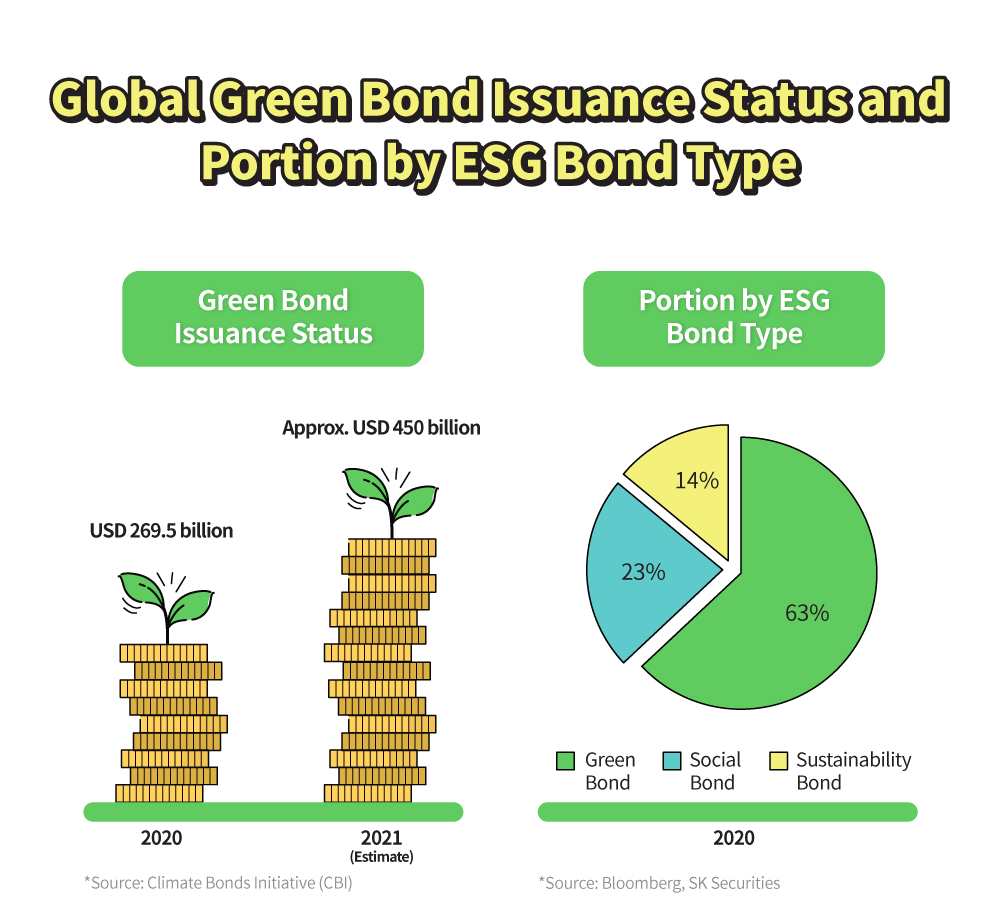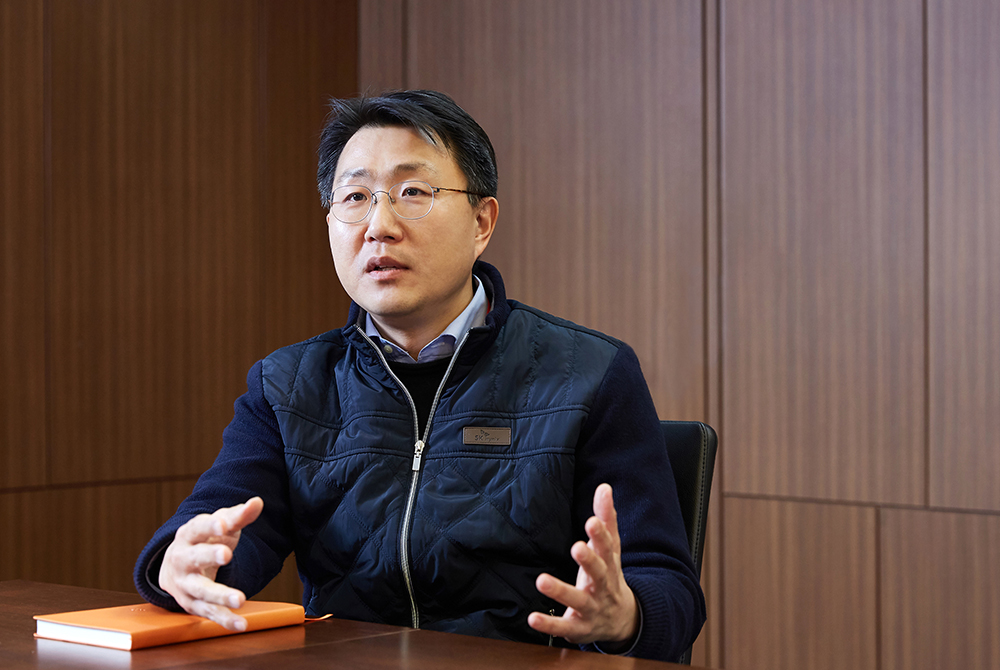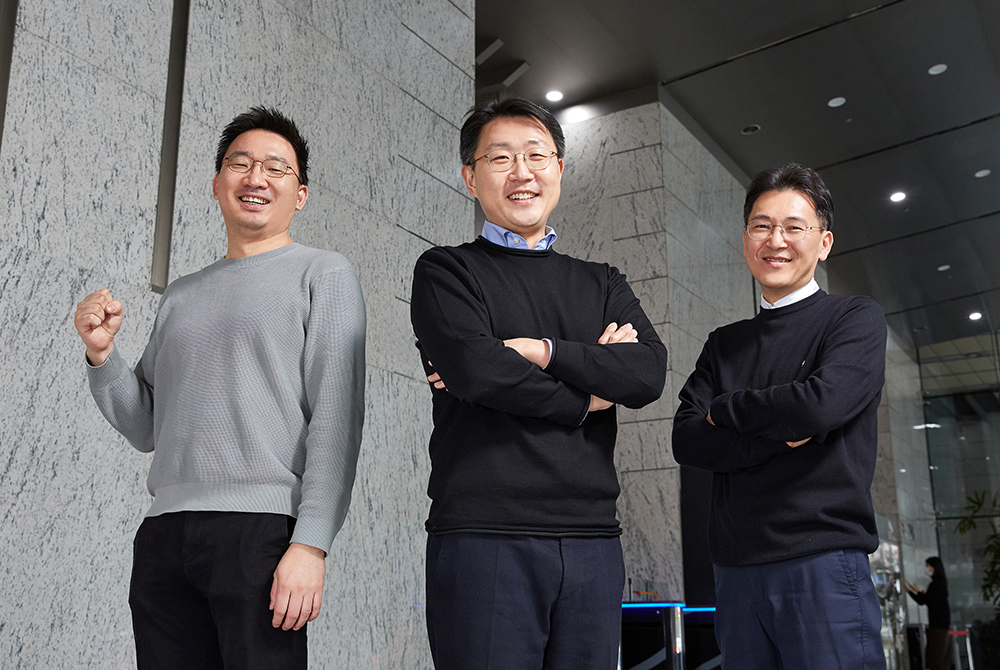SK hynix announced the “Social Value 2030” earlier this year and started to implement its “Financial Story”1 in earnest. At the center of it, therein lies “new entrepreneurship” to empathize with society and cooperate to solve problems. To achieve this vision, SK hynix is also spurring its ESG2 management that considers non-financial factors such as environmental impact, social responsibility, and governance transparency of a company.
Especially, at the beginning of this year, SK hynix issued a “green bond” with a value of USD 1 billion to accelerate its ESG management, for the first time among the global memory semiconductor companies. Green bonds are a type of bond with a special purpose, limited to use only to fund environmentally friendly projects. SK hynix also presented its blueprints of carrying out various eco-friendly projects with the funds secured through this bond to strengthen its position as an eco-friendly company.
The newsroom team met key personnel in charge of issuing the green bond, including Head of Finance Management Hyungmo Yang, Project Leader (PL) of Financial Solution Je Woo Heo, and Technical Leader (TL) of Financial Solution Jae Han Park. Through the interview, the newsroom team could hear about the background and the process of SK hynix’s issuance of the green bond, as well as various future eco-friendly projects led by SK hynix using the funds.
The Era of “Social Responsibility” of Companies: Increase in the Issuance of the “ESG Bonds”

ESG bonds refer to bonds with a special purpose issued to raise the funds for socially responsible investment, such as improving the environment, society, and governance. Although there is no accredited standard internationally unified, the standards of the International Capital Market Association (ICMA) and the Climate Bonds Initiative (CBI) are followed in general.
ESG bonds can be divided into the following types according to the purpose and scope of use: “green bond” issued for eco-friendly projects; “social bond” issued to solve social problems, such as job creation, support for the vulnerable, and social infrastructure establishment; and “sustainability bond” where the green bonds and social bonds are combined, for the use for more varied purposes.
Head of Finance Management Hyungmo Yang said, “As the importance of ESG has been highlighted worldwide, interest in ESG bonds for investment in related fields has increased as well. While the conventional management method was focusing on financial performance, the recent method, especially as the company size grows, is emphasizing the level of expectations from stakeholders and the company’s sustainability. This has led to an era where more attention is paid to ESG to actively solve social problems.”
In particular, the basic trend among investors is changing. The United Nations Principles for Responsible Investment (UNPRI)3 announced by the UN in 2006 reflected the ESG issue, making it public worldwide and steadily increasing the proportion of investments focused on ESG. Larry Fink, CEO of BlackRock Inc., the world’s largest asset management corporation highlighted environmental sustainability in his 2021 letter to CEOs, saying that climate risk is investment risk and consistent and improved disclosure of major data should be accessible to assess such risk.
According to statistics from the Global Sustainable Investment Alliance (GSIA), the amount invested in ESG globally in 2018 recorded USD 30,680 billion, showing a three-fold increase compared to 2012. By investment assets, ESG bonds accounted for 36% of the total ESG investment assets, which is the second-largest portion following the stocks (51%). This trend is apparent in Korea as well. As of May 2020, ESG bonds of 413 types and a total of KRW 59 trillion worth were issued, increased by more than 65 times compared to the end of 2018. Issuing companies are also expanding from public corporations and the banking sector to private companies and the secondary banking sector.4
From the perspective of investors, ESG bonds have the advantage of ensuring the stability of investment since the details of the fund use are disclosed transparently, as well as solving the stakeholders’ pain points, that is, social problems. Moreover, from the perspective of companies, ESG bonds allow them to raise the funds necessary for the ESG management stably, and these activities are also used as corporate evaluation factors, enhancing the brand value. As there are advantages in both supply and demand, it is expected that the size of ESG bond issuance will continue to increase further.

Among the ESG bond types, green bonds have the highest proportion. According to SK Securities, green bonds accounted for about 63% of the entire global ESG bonds as of 2020, while social bonds and sustainability bonds accounted for 23% and 14% respectively. The amount of green bond issuance is expected to increase continuously. According to the CBI, it is expected that the scale of the global green bond issuance will greatly increase from USD 269.5 billion in 2020 to USD 400 billion to 450 billion.5
Why are green bonds accounting for a large portion of the ESG bonds? This is mainly because the international community’s interest has increased with the intensified concerns about climate change. Many countries are competitively presenting eco-friendly policies such as greenhouse gas reduction to solve global issues. In line with this, companies have also joined in the action for a sustainable planet. Global companies are now promoting various eco-friendly projects, using green bonds as a means of raising funds for the projects.
The environment sector is also a field where the project performance can be displayed most visibly among the ESG. TL Jae Han Park said, “In the case of projects for the social and governance fields, it is difficult to express the effects quantitatively. For the environment field, however, it is relatively easy to measure the effects with various indicators such as greenhouse gas reduction, energy savings, and pollution degree. This enables preparing a relatively clear framework6, providing the numbers and figures that investors want to see, in an intuitive way.”
SK hynix Issues a USD 1 Billion Green Bond for its “Eco-Friendly Projects”, Accelerating the ESG Management
Recently, SK hynix also joined this trend and issued a green bond to invest in eco-friendly projects, as one of the measures to accelerate its ESG management. This is to inform global investors of various eco-friendly projects currently led by SK hynix such as fab construction and operation, as well as to enhance its reputation as an eco-friendly company.
For the issuance of a green bond, SK hynix prepared a framework to review the eligibility of eco-friendly projects by collaborating with financial, ESG, and environmental organizations. The eligibility of the green bond was evaluated by a third-party verification organization called “Vigeo Eiris”7. Since the work after the issuance is also important especially for a green bond, SK hynix plans to organize and operate a “Green Bond Working Group” with relevant departments.

Head of Finance Management Hyungmo Yang
The evaluation result was very positive. The result was the “Robust” grade, which is the second-highest among the four grades of Advanced, Robust, Limited, and Weak. This means that the environmental improvement impact of the eco-friendly projects included in the framework is clear and the investment decision-making process is well established. Head of Finance Management Hyungmo Yang said, “Green bond eco-friendly projects are selected and the investment decisions are made through the ‘ESG Management Committee’, the highest decision-making body related to the company’s ESG activities. Vigeo Eiris also evaluated that companies with this kind of system are rare.”
SK hynix held an investment briefing and proceeded with the procedures for the issuance in earnest. Initially, the company planned to raise orders worth around USD 500 million with a maturity of 10 years, but orders of USD 5.4 billion from over 230 institutional investors from around the world were made, allowing the company to succeed in raise orders over five times the amount issued. In the end, SK hynix could issue a green bond of USD 1 billion worth, beyond the issuance scale originally targeted.

TL of Financial Solution Jae Han Park
Despite the bond’s maturity of 10 years, which can be burdensome for investors, how could the bond attract so many orders beyond the expectations? TL of Financial Solution Jae Han Park said, “Earlier this year, SK hynix declared ‘Social Value 2020’. At the same time, it seems that the company’s sincerity to implement its ‘Financial Story’, which is SK hynix’s vision to contribute to humanity and society by strengthening the ESG management, while pursuing a balanced growth of DRAM and NAND Flash businesses at the same time. This seems to be the result of the investors’ recognition for the company’s long-term growth potential, Green 20308 project, and consistent movements for the environment continued for long, such as joining the RE1009 for the first time in Korea.”

PL of Financial Solution Je Woo Heo
The memory semiconductor business, the so-called “smokestack industry”, consumes a lot of energy and toxic raw and subsidiary materials, making it perceived as an industry far from eco-friendliness. SK hynix, however, succeeded in issuing a green bond for the first time among global memory semiconductor companies, breaking such stereotypes and securing the initiative as an eco-friendly company.
PL of Financial Solution Je Woo Heo evaluated this by saying, “The issuance of a green bond this time is an important turning point where SK hynix secured a driving force for maintaining the initiative as an eco-friendly company.” He also said, “We will continue to pursue the right direction as an eco-friendly company by discovering many eco-friendly items and actively carrying out related projects, based on the ESG management philosophy.”
“Sustainable Growth as an Eco-friendly Company through the Green Bond and Expectation to Spread Good Influence in the Semiconductor Industry”
How and where will SK hynix use the funds secured by the green bond? SK hynix plans to use the funds to carry out projects in various fields including sustainable water quality control, energy efficiency improvement, pollution prevention, and ecological environment creation. Each of these project fields was selected in consideration of the characteristics of the semiconductor industry where a large amount of energy and water is consumed and the resulting environmental impact.

Firstly, for the “Sustainable Water Quality Control” project, the company plans to continue to invest in treatment facilities for recycling a large amount of water used in the production process as well as wastewater treatment plants to upgrade them. As water is used the most in the semiconductor production process, investment in water treatment accounts for a high proportion of the overall project. Also, the company plans to create various social values related to “water” by supplying clean water to local communities where SK hynix’s business sites are located through wide-area water supply projects.
Secondly, the “Energy Efficiency Improvement” project seeks ways to use energy more efficiently through product development, equipment replacement, work environment optimization, and so on. In particular, reducing greenhouse gas emissions through the development of low-power solid-state drives (SSDs) is the key task. The power consumption of low-power SSDs is 94% less than that of hard disk drives (HDDs). If HDDs in data centers around the world are replaced with low-power SSDs, greenhouse gas emissions are expected to be reduced by more than 40 million tons by 2030.
Thirdly, the “Pollution Prevention” project is to contribute to the reduction of pollutants through the establishment of nitrogen oxide (NOx) reduction infrastructure and reduction of environmental pollutants. For this project, the establishment of an environmental analysis system that can test in advance whether harmful substances are generated from raw and subsidiary materials was selected as a key task.
Lastly, the “Ecological Environment Creation” project aims to contribute to the conservation of terrestrial and aquatic ecosystems through the creation of ecological parks. The ecological parks are expected to provide a space for locals to enjoy leisure activities. Moreover, even if wastewater is leaked out due to an unexpected accident, the wastewater will be induced to flow into the water storage tank (a device installed to collect rainwater, sewage, or wastewater) located in the ecological park so that it can serve as a protective device for the environmental safety.
In the implementation process of each project, various departments will collaborate organically through the “Green Bond Working Group” to closely examine the business feasibility and environmental improvement effects of the eco-friendly project. At the same time, the “ESG Management Committee” plans to decide whether to promote a project and execute the investments raised through the green bond. Also, through a follow-up report, the usage of the funds, the following results, and the unallocated fund amount will be transparently disclosed annually on the SK hynix website.
PL Heo said, “Although it is a 10-year maturity bond, it is expected that all funds will be used within three years, considering investors’ expectations and project implementation plans.”
SK hynix plans to commit itself to create social values and pursuing the happiness of stakeholders through ESG management. Also, the company is establishing a plan to secure additional funds for this plan. A green loan10 can be implemented by using the green bond framework at the moment, and there is a possibility of additionally issuing a social bond or sustainability bond.

Lastly, the newsroom team heard about the future that SK hynix is drawing up through various eco-friendly projects mentioned earlier.
“The ultimate goal is to develop into a company that pursues the happiness of stakeholders while creating social values at the same time, not simply pursuing economic profits. A company where each of its employees discovers the possibilities of creating ESG in their tasks and participates in the related activities voluntarily and a company that achieves sustainable growth by running ethical and eco-friendly businesses are the future that SK hynix is aiming for. To achieve this, we will continue to discover and promote projects suitable for ESG management.”
1Financial Story: SK Group’s new management strategy to increase the total value that includes corporate value by presenting the growth strategy and future vision of each subsidiary company of SK to various stakeholders such as customers, investors, and the market, generating trust and sympathy. SK hynix has established and initiated in earnest its Financial Story to contribute to humanity and society by strengthening ESG while pursuing continuous business growth through DRAM and NAND as two main pillars.
2ESG: An abbreviation for the environment, social, and governance, which stands for a standard for determining a company’s non-financial performance; it is not imperative to do good things, but an empirical standard of improving corporate sustainability by pursuing ESG. The term ESG was first introduced in “Who Cares Wins: Connecting Financial Markets to a Changing World”, a report used in a letter in 2004 by the UN Secretary-General Kofi Annan to 50 CEOs of global investment institutions in order to request their participation in the UN Global Compact. In January 2005, at a conference co-hosted by the UNGC, the World Bank Group (WBG), and the Government of Switzerland, the term ESG appeared with the presentation “Who Cares Wins: Investing for Long-Term Value”.
3United Nations Principles for Responsible Investment: Principles of investing in companies exerting a positive influence on the environment (E) or society (S), or companies with excellent corporate governance (G)
4Recent Global ESG Investment and Policy Trends, Jung-sun Ryu, Korea Financial Investment Association (KOFIA) (June 2020)
5Source: https://www.climatebonds.net/2021/01/record-2695bn-green-issuance-2020-late-surge-sees-pandemic-year-pip-2019-total-3bn
6Framework: Report on the use of invested funds and expected effects of the investment
7To issue a green bond, it is necessary to go through a procedure for the evaluation of the eligibility of the green bond by a verification organization specialized in green bonds; although no laws and standards are stipulating the requirements, the “Green Bond Principles (GBP)” of the International Capital Market Association (ICMA) or the “Climate Bond Standards” of the Climate Bonds Initiative (CBI) are followed in general.
8Green 2030: Plan in the environmental sector among the SK hynix’s mid-to-long-term plan “SV 2030” roadmaps to maximize the social value creation, with a goal to be achieved by 2030
9RE100: Renewable Energy 100; Convened in 2014 by The Climate Group, a non-profit organization headquartered in the UK, RE100 is an initiative of businesses committed to 100% renewable electricity, and over 280 companies around the world are joining this initiative (as of 2021)
10Green loan: Loan instruments made available exclusively to finance eco-friendly projects and eco-friendly infrastructure businesses, such as new and renewable energy and electric cars







